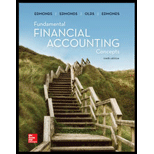
Fundamental Financial Accounting Concepts
10th Edition
ISBN: 9781259918186
Author: Thomas P Edmonds, Christopher Edmonds, Frances M McNair, Philip R Olds
Publisher: McGraw-Hill Education
expand_more
expand_more
format_list_bulleted
Question
Chapter 8, Problem 1AE
To determine
Give some examples of long-term operational assets that each of the following companies is likely to own.
Expert Solution & Answer
Want to see the full answer?
Check out a sample textbook solution
Students have asked these similar questions
I am trying to find the accurate solution to this general accounting problem with the correct explanation.
Please provide the answer to this general accounting question with proper steps.
Please explain the solution to this general accounting problem using the correct accounting principles.
Chapter 8 Solutions
Fundamental Financial Accounting Concepts
Ch. 8 - Prob. 1QCh. 8 - Prob. 2QCh. 8 - Prob. 3QCh. 8 - Prob. 4QCh. 8 - Prob. 5QCh. 8 - Prob. 6QCh. 8 - Prob. 7QCh. 8 - Prob. 8QCh. 8 - Prob. 9QCh. 8 - Prob. 10Q
Ch. 8 - Prob. 11QCh. 8 - Prob. 12QCh. 8 - Prob. 13QCh. 8 - Prob. 14QCh. 8 - Prob. 15QCh. 8 - Prob. 16QCh. 8 - Prob. 17QCh. 8 - Prob. 18QCh. 8 - Prob. 19QCh. 8 - Prob. 20QCh. 8 - Prob. 21QCh. 8 - Prob. 22QCh. 8 - Prob. 23QCh. 8 - Prob. 24QCh. 8 - Prob. 25QCh. 8 - Prob. 26QCh. 8 - Prob. 27QCh. 8 - Prob. 28QCh. 8 - Prob. 29QCh. 8 - Prob. 30QCh. 8 - Prob. 31QCh. 8 - Prob. 32QCh. 8 - Prob. 1AECh. 8 - Prob. 2AECh. 8 - Prob. 3AECh. 8 - Prob. 4AECh. 8 - Prob. 5AECh. 8 - Prob. 6AECh. 8 - Prob. 7AECh. 8 - Prob. 8AECh. 8 - Prob. 9AECh. 8 - Prob. 10AECh. 8 - Prob. 11AECh. 8 - Prob. 12AECh. 8 - Prob. 13AECh. 8 - Prob. 14AECh. 8 - Prob. 15AECh. 8 - Prob. 16AECh. 8 - Prob. 17AECh. 8 - Prob. 18AECh. 8 - Prob. 19AECh. 8 - Prob. 20AECh. 8 - Prob. 21AECh. 8 - Prob. 22AECh. 8 - Prob. 23AECh. 8 - Prob. 24AECh. 8 - Prob. 25APCh. 8 - Prob. 26APCh. 8 - Prob. 27APCh. 8 - Prob. 28APCh. 8 - Prob. 29APCh. 8 - Prob. 30APCh. 8 - Prob. 31APCh. 8 - Prob. 33APCh. 8 - Prob. 34APCh. 8 - Prob. 35APCh. 8 - Prob. 36APCh. 8 - Prob. 1BECh. 8 - Prob. 2BECh. 8 - Prob. 3BECh. 8 - Prob. 4BECh. 8 - Prob. 5BECh. 8 - Prob. 6BECh. 8 - Prob. 7BECh. 8 - Prob. 8BECh. 8 - Prob. 9BECh. 8 - Prob. 10BECh. 8 - Prob. 11BECh. 8 - Prob. 12BECh. 8 - Prob. 13BECh. 8 - Prob. 14BECh. 8 - Prob. 15BECh. 8 - Prob. 16BECh. 8 - Prob. 17BECh. 8 - Prob. 18BECh. 8 - Prob. 19BECh. 8 - Prob. 20BECh. 8 - Prob. 21BECh. 8 - Prob. 22BECh. 8 - Prob. 23BECh. 8 - Prob. 24BECh. 8 - Prob. 25BPCh. 8 - Prob. 26BPCh. 8 - Prob. 27BPCh. 8 - Prob. 28BPCh. 8 - Prob. 29BPCh. 8 - Prob. 30BPCh. 8 - Prob. 31BPCh. 8 - Prob. 33BPCh. 8 - Prob. 34BPCh. 8 - Prob. 35BPCh. 8 - Prob. 36BPCh. 8 - Prob. 1ATCCh. 8 - Prob. 3ATCCh. 8 - Prob. 4ATCCh. 8 - Prob. 5ATCCh. 8 - Prob. 6ATCCh. 8 - Prob. 7ATCCh. 8 - Prob. 8ATCCh. 8 - Prob. 9ATCCh. 8 - Prob. 10ATCCh. 8 - Prob. 1CP
Knowledge Booster
Similar questions
- Please provide the accurate answer to this general accounting problem using valid techniques.arrow_forwardWipro Plastics uses the weighted-average method in its process costing system. Department A had 4,000 units in beginning work-in-process (60% complete for conversion costs), started 16,000 new units during the period, and transferred 18,000 completed units to Department B. If the ending work-in-process in Department A was 2,000 units (30% complete for conversion costs), what are the equivalent units for conversion costs for the period?arrow_forwardCan you solve this general accounting question with accurate accounting calculations?arrow_forward
- I am looking for the correct answer to this general accounting problem using valid accounting standards.arrow_forwardI need the correct answer to this financial accounting problem using the standard accounting approach.arrow_forwardI need assistance with this financial accounting question using appropriate principles.arrow_forward
- I am searching for the accurate solution to this financial accounting problem with the right approach.arrow_forwardPlease explain the solution to this financial accounting problem with accurate principles.arrow_forwardWhat is the total amount of variable costs related to the units sold?arrow_forward
arrow_back_ios
SEE MORE QUESTIONS
arrow_forward_ios
Recommended textbooks for you

 AccountingAccountingISBN:9781337272094Author:WARREN, Carl S., Reeve, James M., Duchac, Jonathan E.Publisher:Cengage Learning,
AccountingAccountingISBN:9781337272094Author:WARREN, Carl S., Reeve, James M., Duchac, Jonathan E.Publisher:Cengage Learning, Accounting Information SystemsAccountingISBN:9781337619202Author:Hall, James A.Publisher:Cengage Learning,
Accounting Information SystemsAccountingISBN:9781337619202Author:Hall, James A.Publisher:Cengage Learning, Horngren's Cost Accounting: A Managerial Emphasis...AccountingISBN:9780134475585Author:Srikant M. Datar, Madhav V. RajanPublisher:PEARSON
Horngren's Cost Accounting: A Managerial Emphasis...AccountingISBN:9780134475585Author:Srikant M. Datar, Madhav V. RajanPublisher:PEARSON Intermediate AccountingAccountingISBN:9781259722660Author:J. David Spiceland, Mark W. Nelson, Wayne M ThomasPublisher:McGraw-Hill Education
Intermediate AccountingAccountingISBN:9781259722660Author:J. David Spiceland, Mark W. Nelson, Wayne M ThomasPublisher:McGraw-Hill Education Financial and Managerial AccountingAccountingISBN:9781259726705Author:John J Wild, Ken W. Shaw, Barbara Chiappetta Fundamental Accounting PrinciplesPublisher:McGraw-Hill Education
Financial and Managerial AccountingAccountingISBN:9781259726705Author:John J Wild, Ken W. Shaw, Barbara Chiappetta Fundamental Accounting PrinciplesPublisher:McGraw-Hill Education


Accounting
Accounting
ISBN:9781337272094
Author:WARREN, Carl S., Reeve, James M., Duchac, Jonathan E.
Publisher:Cengage Learning,

Accounting Information Systems
Accounting
ISBN:9781337619202
Author:Hall, James A.
Publisher:Cengage Learning,

Horngren's Cost Accounting: A Managerial Emphasis...
Accounting
ISBN:9780134475585
Author:Srikant M. Datar, Madhav V. Rajan
Publisher:PEARSON

Intermediate Accounting
Accounting
ISBN:9781259722660
Author:J. David Spiceland, Mark W. Nelson, Wayne M Thomas
Publisher:McGraw-Hill Education

Financial and Managerial Accounting
Accounting
ISBN:9781259726705
Author:John J Wild, Ken W. Shaw, Barbara Chiappetta Fundamental Accounting Principles
Publisher:McGraw-Hill Education